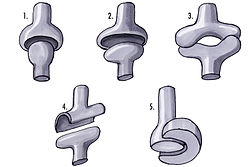Condyloid joint
| Condyloid joint | |
|---|---|
 1: Ball and socket joint; 2: Condyloid joint (Ellipsoid); 3: Saddle joint; 4 Hinge joint; 5: Pivot joint; | |
 Ligaments of wrist. Palmaris view | |
| Details | |
| Identifiers | |
| Latin | articulatio ellipsoidea |
| TA98 | A03.0.00.049 |
| TA2 | 1561 |
| FMA | 75299 |
| Anatomical terminology | |
A condyloid joint (also called condylar, ellipsoidal, or bicondylar[1]) is an ovoid articular surface, or condyle that is received into an elliptical cavity. This permits movement in two planes, allowing flexion, extension, adduction, abduction, and circumduction.
Examples
[edit]Examples include:[2]
These are also called ellipsoid joints. The oval-shaped condyle of one bone fits into the elliptical cavity of the other bone. These joints allow biaxial movements[3] — i.e., forward and backward, or from side to side, but not rotation. Radiocarpal joint and metacarpophalangeal joint are examples of condyloid joints.
An example of an Ellipsoid joint is the wrist; it functions similarly to the ball and socket joint except is unable to rotate 360 degrees; it prohibits axial rotation.
References
[edit]![]() This article incorporates text in the public domain from page 285 of the 20th edition of Gray's Anatomy (1918)
This article incorporates text in the public domain from page 285 of the 20th edition of Gray's Anatomy (1918)
- ^ Rogers, Kara (2010) Bone and Muscle: Structure, Force, and Motion p.163
- ^ Module – Introduction to Joints Archived January 16, 2009, at the Wayback Machine
- ^ "ANATOMY & PHYSIOLOGY: Classification of Joints". Pressbooks. OpenStaxCollege. March 6, 2013. Retrieved 3 June 2023.
